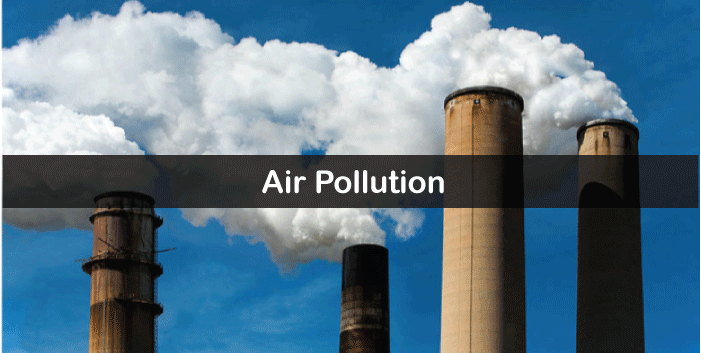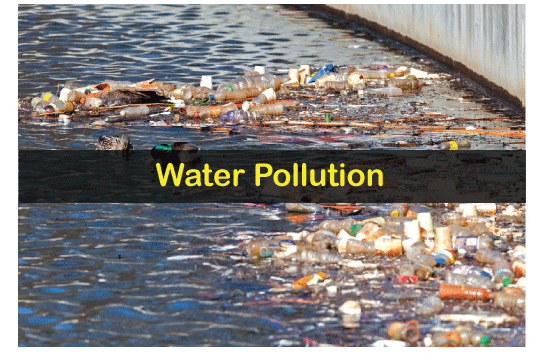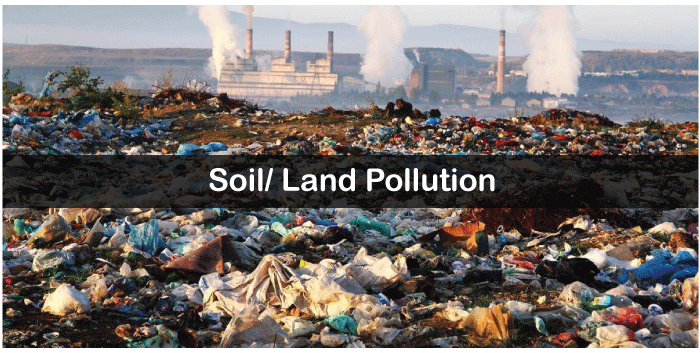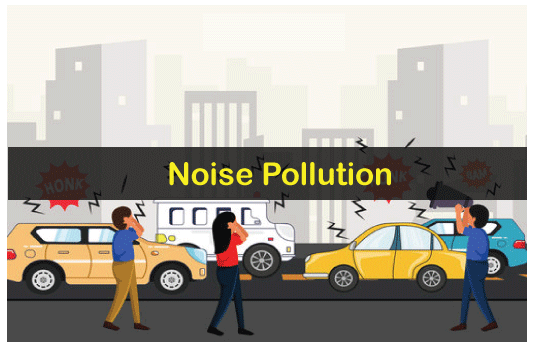Types of PollutionWhen it comes to keeping our environment clean and safe, pollution is considered the biggest issue. Pollution is a global problem. There are various types of pollution affecting the environment and human health. Although humans are continually innovating new things and improving living, new issues have also arisen. The pollution is the result. In this article, we are discussing various types of pollution that are affecting the environment and living. Before we discuss different types of pollution, let us first discuss the definition of pollution. What is Pollution?According to a definition, "Pollution is the introduction of harmful material or substances (or energy) that cause adverse changes in the environment and living entities. These harmful materials are known as Pollutants." In other words, pollution refers to such substances that negatively affect the environment or the living organism. It is usually the presence of pollutants in the environment. Pollutants can be natural (e.g., volcanic ash) and human-made (e.g., trash or runoff dumped by factories). Pollutants directly affect the quality of air, water, and soil. Pollution is currently a global issue, and urban areas are comparatively more polluted than in the countryside. Note: Almost all the living things, from microbes to blue whales, rely on Earth's supply of air, food and water. Pollution, even in small amounts, affects the ecological balance. Pollutants can find their way up to the Earth's supply chain and ultimately make their way inside the human body. Pollution in natural resources will put all forms of life in danger.Major Types of PollutionThere are several types of pollution caused either due to natural actions or due to human-made activities. The following is the list of major types of pollution:
Let's discuss each type of pollution: Air PollutionAir pollution is defined by the presence of harmful pollutants in the Earth's atmosphere that affects human health and threatens other living organisms. The excessive amount of pollution can cause a series of health issues or even kill living things. The effects of air pollution directly depend on the amount and the kind of pollutant in the atmosphere. The following are some most common and critical effects of air pollution in humans:
Despite this, the effects of air pollution can also be seen in the environment. This can cause Global warming, Acid rain, Ozone depletion, and Hazards to wildlife, etc. Typically, air pollution and the pollutants are invisible. However, sometimes air pollution can be seen with naked eyes. We can see the air pollutants in the form of dark smoke coming out from factories, chimneys, or even vehicles. They get dissolved in the environment quickly. The other common air pollution type includes gases like sulfur dioxide, carbon monoxide, carbon dioxide, nitrogen oxide and chemical vapors, etc. Many of these are already present in the atmosphere, but they act as pollutants if present in abnormal quantities. 
Natural disasters may sometimes cause air pollution at an extent level. Also, when volcanoes erupt, they produce volcanic ash and dangerous gases in the surrounding area. Volcanic ash can lead to discoloration of the sky for several months. When exceeded more than normal, volcanic gases can lead to nearby residents' death and make the soil infertile for several years. However, most air pollution is not natural and comes due to human untidiness. Besides, Greenhouse gases are another critical source of air pollution. Human activities like fossil fuels and cutting forests have caused an increase in greenhouse gases in the environment, resulting in increased temperatures across the globe than normal. This type of increase in average temperature worldwide due to human activity is known as Global Warming. Water PollutionWater pollution is usually defined by the presence of excess chemical, physical or biological substances that result in the default properties of water and make it harmful to living organisms. Water pollution mainly affects surface water in the environment, such as rivers, lakes, seas, etc. Typically, natural or unpolluted water is colorless, odorless, and transparent. Instead, if the water is cloudy or has bad taste or smell, it is referred to as polluted water symptoms. However, it is not limited to these measures because some water pollutants cannot be seen, and they don't have any taste. Thus, in simple terms, water pollution involves something more than the presence of actual water. Water pollution is usually caused by human activities like improper sewage treatment, oil spills, agricultural runoff, water diversification, air sedimentation, streams' channelization, etc. However, it is not only limited to human activities. Sometimes natural processes like eutrophication can also be the cause of water pollution. This process occurs when the nutrients (e.g., nitrogen) are added to the bodies of water. 
It is strictly suggested not to use polluted water for drinking, washing, bathing, and agriculture. It affects the human body in many ways, depending on the pollution level or the concentration of pollutants. For agriculture, the polluted water can affect the growth of plants or may kill them. Among other major types of pollution, water pollution is considered to be the most dangerous or hazardous. It can cause disastrous consequences on humans, plants and other creatures. Other important effects of water pollution are listed below:
Soil / Land PollutionSoil pollution, also called Land pollution, is the cause of land degradation due to toxic chemicals, pathogenic microorganisms, or other human-made substances in the soil. The polluted soil can also affect human health in one way or another. For instance, liquid wastes containing harmful chemicals may be absorbed slowly into the soil and affect groundwater purity. This will directly affect people's health using the springs or well for drinking water in nearby areas. Another effect of soil pollution can be noticed in plants. The toxic chemicals in the soil will be absorbed by them and passed through the food chain. Since plants are the producers in the environment, the toxic chemical will be consumed by living things. Among all types of pollutants, the effect of soil pollution is considered ambiguous; however, their implications are very notable. Some other effects of soil pollution are listed below:

The land is mostly polluted with domestic waste and industrial waste. This can include solid waste and liquid waste, causing soil pollution at an extreme level. This type of waste can produce a bad odor and attract insects, resulting in several diseases. Generally, the waste is picked up and brought to a dump or landfill. The waste is then buried in the landfill. The trash is recycled accordingly to use for something good. However, some cities burn their garbage when they do not have enough storage to dump their trash. Even though burning the trash can help with soil pollution, it directly increases air pollution in the environment. Noise PollutionNoise pollution is defined as an excessive amount of noise that affects the environment in a disruptive manner. Although noise pollution is not visible and does not smell like air pollution, it still disrupts the natural balance. It is generally caused by human-made activities, though certain natural activities such as volcanic eruption and clouds' bumping can also produce noises. Noise pollution at its peak level can even damage the human hearing system. Typically, the sound measured more than 85 decibels is said to be detrimental. Additionally, the period to which a person is exposed also affects their health. For instance, the normal conversation has measured 60 decibels around, and the sound coming from the plane is measured around 150 decibels. Noise pollution is affecting the environment more obvious than some other types of pollution. The most common noise pollution types include the sound coming from explosions, loudspeakers, industries, planes, and other transport vehicles. Researches have proved that there are several direct effects of noise pollution on human health, causing various diseases. Noise pollution has become very common now due to dense urbanization and industrialization. Some common effects of noise pollution on human beings include the following:

Apart from this, the effect of noise pollution can also be seen in wildlife and underwater mammals. The underwater noise pollution generated through ships or submarines can upset sea creatures' navigation systems, especially for dolphins and whales. This ultimately impacts their movement. In some cases, the excessive amount of noise pollution can also cause death to certain species dependent on the natural underwater world. Also, it is seen that noises force wild species to communicate louder, which may shorten their lifespan. Besides, it also affects the nesting success of birds. Other Types of PollutionThe above-explained types of pollution are the most common. However, there are many other pollution types, such as thermal pollution, radioactive pollution, light pollution, and mercury pollution. These are the rarer forms of pollutions, but they can be the deadliest ones. Thermal PollutionThermal pollution refers to the sudden increase or decrease in natural water bodies' temperature, such as rivers, lakes, or oceans. While many types of pollutions are straightforward, thermal pollution is slightly different. This kind of pollution is usually seen when nuclear power plants or other facilities take water from natural resources to cool its machinery or relevant things and put that used water back into the environment with an altered temperature. The used water wreaks havoc on sea mammals and wildlife because it is low in oxygen. Apart from this, thermal pollution can also be caused by natural sources such as soil erosion, which ultimately provide more sunlight to water. Some other causes of thermal pollution include deforestation, runoff from paved surfaces, and releasing retention ponds water into the river, lake, etc. Radioactive PollutionRadioactive pollution refers to the presence of radioactive substances in the environment. The excess amount of radioactive pollutants in the atmosphere is usually caused by several activities. Some of them include the release of radioactive substances during nuclear explosions, nuclear weapon testing, radioactive wastages, mining of radioactive ores, and nuclear power plants' accidents. Radioactive pollution in the atmosphere can further affect water, water sources, and air space when radioactive fallout happens from the cloud of a nuclear explosion. Radionuclides are the primary source of radioactive pollution, and they emit beta particles and gamma rays, known as radioactive substances. Light PollutionLight pollution is defined as the excessive amount of lights produced by most urban and other populated areas. Lights are great resources for human beings to see in the dark or at night, and most people can even imagine a life without the modern convenience of electric lights. However, light pollution prevents people from seeing the night sky's features and makes it impossible to see stars and galaxies. Researchers have shown that light pollution can make the smog worse by destroying nitrate radicals, which mainly helps smog dispersion. The effects of light pollution can be mostly seen on animals and other natural activities. For instance, light pollution can cause impede migration patterns for birds and other nocturnal animals' activities. Mercury PollutionMercury pollution is another critical type of pollution that harms wildlife and ecosystems. Mercury is found in the Earth's crust, but human activities, such as mining and combustion of fossil fuels, have led to widespread mercury pollution. Mercury emitted into the air can travel several miles in the atmosphere until it is settled back to the Earth in rainfall or dry gaseous form. Natural sources of mercury include volcanic eruptions and emissions from the ocean. On the other side, land, water and other surfaces can repeatedly re-emit mercury into the atmosphere once released into the environment. Some of the mercury circulating through the environment nowadays was released a long ago. Mercury exposure threatens our health, sometimes causing irreversible toxic effects. The mercury emitted in the air eventually settles in water or on the ground, where it can be washed in water. Once deposited, some microorganisms can convert it to methylmercury, a highly toxic form occurred in fish, shellfish, and fish-eating animals. The most human mercury exposure is from fish and shellfish that are contaminated with methylmercury. What Causes Pollution?When it comes to distinguishing the cause of pollution, there isn't just one cause. There are lots of sources of pollution, including natural and human-made. Many things which are meant to help people also create pollution in one way or another. Some of the most common sources that cause maximum pollution are discussed below: Domestic: Generally, the domestic sources of pollution involves wastage or wastewater from kitchens, bathrooms, and toilets. Apart from this, solid wastes from households, shops, markets, and offices also come under domestic pollutants. These pollutants are directly causing pollution at a higher level. However, the pollution via domestic sources can be controlled by properly containing and recycling the pollutants. Such pollutants should not be involved in the environment. Industry: Industries are considered as the critical cause of pollution. Pollution from industrial sectors is a serious concern for the environment. Most industries' operations produce polluting waste or harmful substances discharged to the environment, either through drainage pipes (into the water) or through chimneys (into the air). The most polluting industries include tanneries, food processing, and textiles with plants processing, etc. Such industries produce liquid wastes that are often discharged into rivers without treatment. Agriculture: In addition to industry and domestic sources, agricultural activities are also the cause of pollution. Nowadays, many agricultural activities are using pesticides and fertilizers. Plant fertilizers contain phosphate and nitrate, and if they are washed into water bodies, they are cause excessive growth of plants and vegetation. Apart from this, agricultural activities are also responsible for gaseous pollutants or air pollution. This may include burning feces, farm fires, livestock from crop residues and methane produced by solid pollutants, packaging materials and other wastes similar to those produced domestically. Transport: The transport system is undoubtedly one of the most useful resources for humans. It makes human life a lot easier, either traveling or moving things from one place to another. On the negative side, vehicles used in transportation are the critical cause of pollution. Vehicles differ in size and use different fuel types, such as petrol, diesel, CNG, etc. They also produce polluted substances into the air, causing air pollution. The poorly maintained vehicle or old vehicles can even make the air hazy or smoky. This may lead to coughs and eye irritation in humans. Apart from this, they are also the cause of noise pollution. The condition becomes even worse in traffic jams, especially in big cities. ConclusionThere are different kinds of pollutions all around us. However, we can follow some practices that help reduce pollutions. For instance, we may recycle the products using different measures, dispose of products following proper instructions, use renewable energy sources, etc.
Next TopicEqualize the Array Problem Solution
|
 For Videos Join Our Youtube Channel: Join Now
For Videos Join Our Youtube Channel: Join Now
Feedback
- Send your Feedback to [email protected]
Help Others, Please Share










